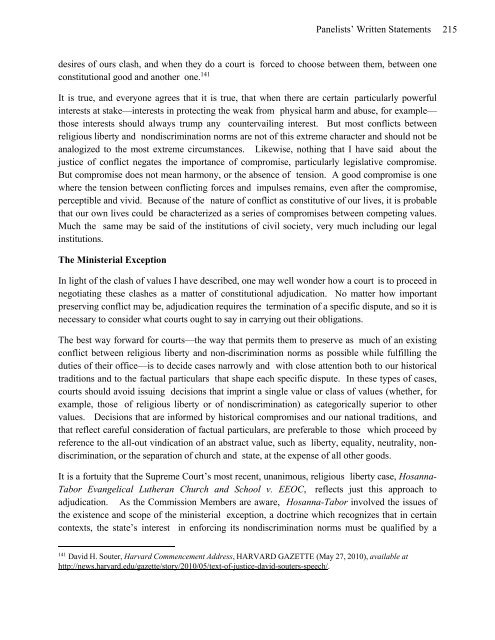PEACEFUL COEXISTENCE
2cgDkdT
2cgDkdT
You also want an ePaper? Increase the reach of your titles
YUMPU automatically turns print PDFs into web optimized ePapers that Google loves.
Panelists’ Written Statements<br />
217<br />
not ideal in certain respects, 146 the Court rightly recognized that on balance, in light of what<br />
both Perich and the church understood and expected from the position, Perich’s job<br />
responsibilities were sufficiently ministerial that she should come within the compass of the rule.<br />
Yet the Court refused to extend that holding any more than necessary. It declined to opine on<br />
other kinds of law suits and other types of positions. 147 And it did not adopt the view that<br />
churches have unbridled discretion to define any job as “ministerial” thereby to circumvent the<br />
state’s laws. That, too, was proper, inasmuch as the fact that a religious institution is involved in<br />
this type of conflict does not diminish, let alone erase, the state’s—or Perich’s own—interest in<br />
vindicating the equal application of non-discrimination laws. 148 That interest remains powerful,<br />
even in the presence of a religious institution in the conflict. But the involvement of a church<br />
does qualify or complicate the government’s interest, introducing important competing values<br />
with which the government’s and Perich’s interests clash. It would be a mistake to select<br />
between these values categorically for constitutional purposes—choosing one set that ought to<br />
dominate the other set in all future cases. It would do violence to commitments each of which<br />
are important features of our political and legal traditions.<br />
It is true that narrow decisions may have costs. A narrow decision may provide less certainty<br />
than a broad decision; it may give prospective litigants less guidance; and it may leave the law<br />
less stable than is optimal. 149 But that same uncertainty and instability may also promote<br />
compromise at the individual level; it may enable courts to communicate effectively with other<br />
government actors; and it may be more honest about the realities of constitutional adjudication—<br />
more candid and therefore more legitimate in a liberal democracy. Most importantly, however,<br />
narrow constitutional decisions avoid the trap of fixing in amber a monolithic ranking of values<br />
and interests. They reserve judgment for future cases and controversies.<br />
146<br />
For example, the nature of the remedy sought—whether money damages or reinstatement—might make a greater<br />
difference than the Court acknowledged. See id. at 709. Furthermore, the discussion of free exercise doctrine was less<br />
than fully persuasive in distinguishing the unduly parsimonious rule applicable to individuals. See id. at 706-07;<br />
Employment Division v. Smith, 494 U.S. 872 (1990).<br />
147<br />
Hosanna-Tabor, 132 S.Ct. at 710 (“There will be time enough to address the applicability to the exception to<br />
other circumstances if and when they arise.”). State and federal courts have already begun to confront these issues,<br />
and in time a mature tradition of judicial doctrine of the ministerial exception will develop. See, e.g.,<br />
http://clrforum.org/2012/08/14/dc-court-of-appeals-first-amendment-does-not-bar-ministers-breach-of-contract-suitagianst-church/;<br />
http://clrforum.org/2013/01/31/new-york-court-dismisses-breach-of-contract-suit-underministerial-exception/.<br />
148<br />
See Hosanna-Tabor, 132 S.Ct. at 710 (“The interest of society in the enforcement of employment discrimination<br />
statutes is undoubtedly important. But so too is the interest of religious groups in choosing who will preach their<br />
beliefs, teach their faith, and carry out their mission.”).<br />
149<br />
Whether this is true will depend on exactly how uniformly the principles underwriting the broader decision are<br />
applied. For an argument that the broad rule in the Smith decision actually provides less guidance than might be<br />
expected, see DEGIROLAMI, THE TRAGEDY OF RELIGIOUS FREEDOM, Chapter 8.


